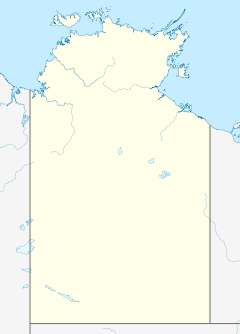Beetaloo

Coordinates: 17°12′58″S 133°48′07″E / 17.216°S 133.802°E Beetaloo is the name of a pastoral lease that operates as a cattle station in the Northern Territory, known as Beetaloo Station. It is also the name of an area in the Sturt Plateau, known as the Beetaloo Sub-Basin or Beetaloo Basin, around 500 kilometres (310 mi) south-east of Darwin, between Mataranka to the north and Elliott to the south. This area is rich in natural gas, which can be exploited by fracking, which has caused controversy.
Beetaloo Station[]
Beetaloo Station is situated about 48 kilometres (30 mi) north east of Elliott and 295 kilometres (183 mi) south west of Borroloola. The property is surrounded by other pastoral leases including Hayfield, Amungee Mungee and Tanumbirini Stations to the north, Hayfield and Newcastle Waters Station to the west, Tandyidgee, Ucharonidge and Mungabroom to the south and the Mambilya-Rrumburriya Aboriginal Land Trust to the east. The Carpentaria Highway crosses the property through the north east corner and the Newcastle Creek flows through a good portion of the lease from east to west.[1]
The property currently occupies an area of 10,500 square kilometres (4,054 sq mi) and was purchased by the Dunnicliff-Armstrong family in 2002 for A$20 million.[2]
The Station was established in the 1890s by Harry M. Bathern who had overlanded cattle to many other properties in the Territory including Brunette Downs, Eva Downs and Emu Downs. When Bathern died in 1928 the property occupied an area of 3,000 square miles (7,770 km2).[3]
Several bushfires in 1951 burnt out a total of 5,000 square miles (12,950 km2) across Beetaloo and neighbouring Newcastle Waters stations, with Beetaloo reported to be one of the worst affected. Compounding the immediate loss of stock and grazing pasture, drought followed the fires leading to further losses of the surviving stock.[4][5] The manager, Wally Bathern, expressed concern that when the wet season arrived, bogs would form around waterholes and the weakened cattle were at risk of becoming stuck.[6]
Beetaloo Sub-basin[]
The Beetaloo Sub-basin, is situated in the Sturt Plateau region, between Mataranka to the north and Elliott to the south. It covers an area of approximately 2,800,000 hectares about 500 kilometres south-east of Darwin. The Beetaloo Sub-basin is a structural component of the greater McArthur Basin. The McArthur Basin covers a range of Proterozoic sedimentary rock formations that range from the northern part of the Northern Territory from north-east WA to north-west Queensland.[7]
The Beetaloo Sub-basin is prospective for unconventional hydrocarbons. It is estimated to contain significant amounts of recoverable shale gas, tight gas and shale oil resources. Petroleum exploration in the Beetaloo area first began in 1984 when CRA Exploration Pty Limited took up acreage in exploration permits EP4 and EP5 (since lapsed), north of the core of the Beetaloo. Exploration for shale resources was revitalized in 2015 when Origin Energy drilled two vertical exploration wells (Kalala S-l and Amungee NW-l) and one horizontal well (Amungee NV/-IH).
On 14 September 2017 the Northern Territory Government announced a scientific inquiry into hydraulic fracturing of onshore unconventional reservoirs in the Northern Territory under the Inquiries Act (NT).[8] This inquiry was led by Justice Rachel Pepper and supported by a panel of independent experts. Following 15 months of investigating the issue, the inquiry found the risks of fracking could be reduced to acceptable levels if 135 recommendations were implemented in full.
Economic modelling by the industry found that the development of the Beetaloo basin could "create more than 6500 full-time jobs and positive economic impacts of up to $2.8 billion for the Northern Territory and over $9 billion for Australia as a whole over 25 years."[9] However, many members of the community, pastoralists and traditional Aboriginal caretakers of the land continue to raise concerns that rivers and water sources in the region could be polluted by the waste produced by hydraulic fracturing.[10]
The Indigenous rangers working in the new Indigenous Protected Area are very concerned about the level of greenhouse gases which would be released by the fracking work, potentially jeopardising Australia's Paris emissions reduction target.[11]
See also[]
References[]
- ^ "Northern Territory Pastoral Properties" (PDF). Northern Territory Government. 2003. Archived from the original (PDF) on 9 April 2015. Retrieved 9 April 2015.
- ^ Matthew Cawood (29 April 2014). "Making water work at Beetaloo". The Land. Fairfax Media. Archived from the original on 10 April 2015. Retrieved 10 April 2015. at a cost of A$20 million.
- ^ "A northern pioneer". The Chronicle. Adelaide: National Library of Australia. 21 April 1928. p. 21. Retrieved 10 April 2015.
- ^ "Toll Of Fire In Northern Territory". The West Australian. Perth: National Library of Australia. 26 November 1951. p. 1. Retrieved 10 April 2015.
- ^ "Bush Fire Threat To Stations". The Examiner. Launceston, Tasmania: National Library of Australia. 25 June 1951. p. 8. Retrieved 7 May 2017.
- ^ "Heavy N.T. stock loss". The News. Adelaide: National Library of Australia. 27 November 1951. p. 5. Retrieved 10 April 2015.
- ^ Geoscience Australia. Geology of the Beetaloo GBA region. Technical appendix for the Geological and Bioregional Assessment: 2020
- ^ "The Scientific Inquiry into Hydraulic Fracturing in the Northern Territory". 2016. Retrieved 16 August 2021.
- ^ "Onshore gas drilling to boost NT economy". 7 News. 18 April 2019. Retrieved 11 April 2021.
- ^ Judd, Bridget (15 April 2018). "The battle for Beetaloo: The basin at the heart of the fracking debate". ABC News. Australian Broadcasting Corporation. Retrieved 1 March 2020.
- ^ Bardon, Jane (29 February 2020). "The gas field so big it could knock Australia off course from our climate target". ABC News. Australian Broadcasting Corporation. Retrieved 1 March 2020.
- Stations (Australian agriculture)
- Pastoral leases in the Northern Territory
- Sedimentary basins of Australia
- Geology of the Northern Territory
